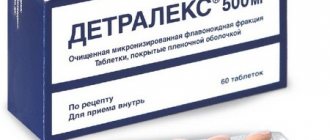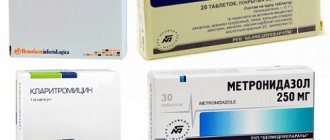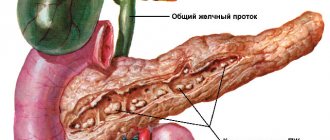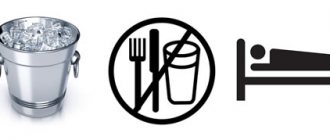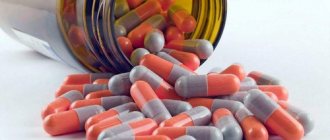Treatment of cholecystitis with antibiotics is often mandatory. If the source of the infectious process is not eliminated, the disease can be complicated by the formation of an abscess, suppuration of the bladder and ducts, which can subsequently even lead to death.
To prevent this, treatment of cholecystitis should include a complex of drugs, including antibiotics.
Indications for taking antibiotics for cholecystitis
Direct indications for antibiotic therapy for cholecystitis are:
- severe pain in the liver area, which tends to increase;
- significant increase in temperature (up to +38.5-39°C);
- severe digestive disorders, with diarrhea and repeated vomiting;
- spread of pain throughout the abdomen (so-called “spread” pain);
- the presence of other infectious diseases in the patient;
- signs of an infectious process detected as a result of a blood test.
Overdose
With excessive use of tablets or frequent injections of antibiotics, the following problems may arise:
- Pain syndrome in the abdominal area;
- Nausea with vomiting;
- Stool disorder;
- Excessive gas formation.
In this case, it is recommended to stop using the product and contact a specialist. The doctor usually prescribes symptomatic therapy. At the same time, professionals advise drinking more plain water without carbon to restore water and electrolyte balance.
An overdose of drugs can also lead to kidney pathologies and aggravation of cholecystitis.
Names of antibiotics that are often prescribed for cholecystitis
- Azithromycin is an antibiotic that comes in the form of capsules or tablets. The drug is taken between meals, at an average dosage of 1 g per dose.
- Zitrolide is an analogue of Azithromycin, which is available in capsule form and has a prolonged effect - that is, it is enough to take one capsule of the drug per day.
- Sumalek is a macrolide antibiotic, available in the form of tablets or powder. The drug is convenient to use, as it requires a single dose during the day. The duration of therapy with Sumalek is determined by the doctor.
- Azicar is a capsulated antibiotic that copes well with combined inflammatory processes - for example, it is often prescribed for cholecystopancreatitis. The standard dosage of the drug is 1 g once a day, between meals.
- Amoxil is a combination antibiotic with active ingredients such as amoxicillin and clavulanic acid. Amoxil can be used in the form of tablets, or administered as injections and infusions, at the discretion of the doctor.
- Flemoxin Solutab is a special form of amoxicillin in the form of soluble tablets, which allows for rapid and complete absorption of the drug in the gastrointestinal tract. Flemoxin Solutab is prescribed for cholecystitis, both for children (from 1 year old) and for adult patients.
What can replace antibiotics?
Antibiotics for cholecystitis may not be suitable due to individual intolerance. In case of urgent need, antibacterial drugs can be replaced with sulfonamides. These are antimicrobial drugs that have a wide spectrum of action.
Their advantages:
- practically non-toxic to the body;
- relatively inexpensive;
- can be used by children;
- active against dividing strains.
Among the effective representatives are:
- Sulfadimezin. Available in tablet form. It is not used for children under three years of age, for patients with individual intolerance, for hematopoietic disorders, and if diagnostics have shown high levels of bilirubin.
- Sulfadimethoxine. The medicine effectively fights pathogens such as Klebsiella, staphylococcus, and E. coli.
- Sulfalene. It can be used in tablet form and also as injections (intramuscular and intravenous). Headaches, allergies, and a decrease in white blood cell levels may occur.
In addition, herbs are also used for cholecystitis. But even so, treatment should be discussed with a specialist. And in order for the use of medications to produce results as quickly as possible, we must not forget about a special diet that will reduce the load on the gallbladder and liver, thereby improving the general condition of the body.
Cholecystitis is a completely curable disease. The patient’s main task is to seek qualified help in a timely manner and strictly follow all doctor’s recommendations.
Due to various circumstances, antibacterial therapy is contraindicated. Herbal remedies cannot cope with the growing colony of bacteria. In this case, the prescription of sulfonamides is justified. They are not as effective, but they have several advantages:
- low level of toxicity;
- no contraindications for children;
- low price.
This group includes Sulfadimezin, Sulfadimethoxine, Phthalazole. Sulfonamides are prescribed for the treatment of gallbladder infections and pathological processes in the gastrointestinal tract.
Yuliia Yevtiekhova
20.02.2019
14 min. for reading
My name is Yulia and I am a general practitioner. In my free time, I direct my knowledge and experience to a wider audience: I write medical articles for patients.
Ask a questionDiplomaMake an appointment
Literature
- Cherenkov, V. G. Clinical oncology: textbook. manual for the postgraduate system. education of doctors / V. G. Cherenkov. – Ed. 3rd, rev. and additional – M.: MK, 2010. – 434 p.: ill., table.
- Ilchenko A.A. Diseases of the gallbladder and biliary tract: A guide for doctors. — 2nd ed., revised. and additional - M.: Publishing House "Medical Information Agency", 2011. - 880 p.: ill.
- Tukhtaeva N. S. Biochemistry of biliary sludge: Dissertation for the degree of candidate of medical sciences / Institute of Gastroenterology of the Academy of Sciences of the Republic of Tajikistan. Dushanbe, 2005
- Litovsky, I. A. Gallstone disease, cholecystitis and some diseases associated with them (issues of pathogenesis, diagnosis, treatment) / I. A. Litovsky, A. V. Gordienko. — St. Petersburg: SpetsLit, 2021. — 358 p.
- Dietetics / Ed. A. Yu. Baranovsky - Ed. 5th - St. Petersburg: Peter, 2021. - 1104 p.: ill. — (Series “The Doctor’s Companion”)
- Podymova, S.D. Liver diseases: A guide for doctors / S.D. Podymova. — Ed. 5th, revised and additional - Moscow: Medical Information Agency LLC, 2021. - 984 p.: ill.
- Schiff, Eugene R. Introduction to Hepatology / Eugene R. Schiff, Michael F. Sorrell, Willis S. Maddray; lane from English edited by V. T. Ivashkina, A. O. Bueverova, M.V. Mayevskaya. – M.: GEOTAR-Media, 2011. – 704 p. – (Series “Liver diseases according to Schiff”).
- Radchenko, V.G. Fundamentals of clinical hepatology. Diseases of the liver and biliary system. – St. Petersburg: “Dialect Publishing House”; M.: “Publishing house BINOM”, – 2005. – 864 p.: ill.
- Gastroenterology: Handbook / Ed. A.Yu. Baranovsky. – St. Petersburg: Peter, 2011. – 512 p.: ill. – (National Library of Medicine Series).
- Lutai, A.V. Diagnosis, differential diagnosis and treatment of diseases of the digestive system: Textbook / A.V. Lutai, I.E. Mishina, A.A. Gudukhin, L.Ya. Kornilov, S.L. Arkhipova, R.B. Orlov, O.N. Aleutian. – Ivanovo, 2008. – 156 p.
- Akhmedov, V.A. Practical gastroenterology: A guide for doctors. – Moscow: Medical Information Agency LLC, 2011. – 416 p.
- Internal diseases: gastroenterology: A textbook for classroom work of 6th year students in specialty 060101 - general medicine / comp.: Nikolaeva L.V., Khendogina V.T., Putintseva I.V. – Krasnoyarsk: type. KrasSMU, 2010. – 175 p.
- Radiology (radiation diagnostics and radiation therapy). Ed. M.N. Tkachenko. – K.: Book-plus, 2013. – 744 p.
- Illarionov, V.E., Simonenko, V.B. Modern methods of physiotherapy: A guide for general practitioners (family doctors). – M.: OJSC “Publishing House “Medicine”, 2007. – 176 p.: ill.
- Schiff, Eugene R. Alcohol, drug, genetic and metabolic diseases / Eugene R. Schiff, Michael F. Sorrell, Willis S. Maddray: trans. from English edited by N.A. Mukhina, D.T. Abdurakhmanova, E.Z. Burnevich, T.N. Lopatkina, E.L. Tanashchuk. – M.: GEOTAR-Media, 2011. – 480 p. – (Series “Liver diseases according to Schiff”).
- Schiff, Eugene R. Liver cirrhosis and its complications. Liver transplantation / Eugene R. Schiff, Michael F. Sorrell, Willis S. Maddray: trans. from English edited by V.T. Ivashkina, S.V. Gauthier, J.G. Moysyuk, M.V. Mayevskaya. – M.: GEOTAR-Media, 201st. – 592 p. – (Series “Liver diseases according to Schiff”).
- Pathological physiology: Textbook for medical students. universities / N.N. Zaiko, Yu.V. Byts, A.V. Ataman et al.; Ed. N.N. Zaiko and Yu.V. Bytsya. – 3rd ed., revised. and additional – K.: “Logos”, 1996. – 644 p.; Ill. 128.
- Frolov V.A., Drozdova G.A., Kazanskaya T.A., Bilibin D.P. Demurov E.A. Pathological physiology. – M.: OJSC Publishing House “Economy”, 1999. – 616 p.
- Mikhailov, V.V. Fundamentals of pathological physiology: A guide for doctors. – M.: Medicine, 2001. – 704 p.
- Internal medicine: Textbook in 3 volumes - Vol. 1 / E.N. Amosova, O. Ya. Babak, V.N. Zaitseva and others; Ed. prof. E.N. Amosova. – K.: Medicine, 2008. – 1064 p. 10 s. color on
- Gaivoronsky, I.V., Nichiporuk, G.I. Functional anatomy of the digestive system (structure, blood supply, innervation, lymphatic drainage). Tutorial. – St. Petersburg: Elbi-SPb, 2008. – 76 p.
- Surgical diseases: Textbook. / Ed. M.I. Kuzina. – M.: GEOTAR-Media, 2021. – 992 p.
- Surgical diseases. Guide to examining a patient: Textbook / Chernousov A.F. and others - M.: Practical Medicine, 2016. - 288 p.
- Alexander JF, Lischner MN, Galambos JT Natural history of alcoholic hepatitis. 2. The longterm prognosis // Amer. J. Gastroenterol. – 1971. – Vol. 56. – P. 515-525
- Deryabina N.V., Ailamazyan E.K., Voinov V.A. Cholestatic hepatosis in pregnant women: pathogenesis, clinical picture, treatment // Zh. obstetrics. and wives disease 2003. No. 1.
- Pazzi P., Scagliarini R., Sighinolfi D. et al. Nonsteroidal antiinflammatory drug use and gallstone disease prevalence: a case-control study // Amer. J. Gastroenterol. – 1998. – Vol. 93. – P. 1420–1424.
- Marakhovsky Yu.Kh. Gallstone disease: on the way to diagnosing early stages // Ros. magazine gastroenterol., hepatol., coloproctol. – 1994. – T. IV, No. 4. – P. 6–25.
- Higashijima H., Ichimiya H., Nakano T. et al. Deconjugation of bilirubin accelerates coprecipitation of cholesterol, fatty acids, and mucin in human bile–in vitro study // J. Gastroenterol. – 1996. – Vol. 31. – P. 828–835
- Sherlock S., Dooley J. Diseases of the liver and biliary tract: Trans. from English / Ed. Z.G. Aprosina, N.A. Mukhina. – M.: GEOTAR Medicine, 1999. – 860 p.
- Dadvani S.A., Vetshev P.S., Shulutko A.M., Prudkov M.I. Cholelithiasis. – M.: Publishing house. House “Vidar-M”, 2000. – 150 p.
- Yakovenko E.P., Grigoriev P.Ya. Chronic liver diseases: diagnosis and treatment // Rus. honey. zhur. – 2003. – T. 11. – No. 5. – P. 291.
- Sadov, Alexey Cleansing the liver and kidneys. Modern and traditional methods. – St. Petersburg: Peter, 2012. – 160 pp.: ill.
- Nikitin I.G., Kuznetsov S.L., Storozhakov G.I., Petrenko N.V. Long-term results of interferon therapy for acute HCV hepatitis. // Ross. magazine gastroenterology, hepatology, coloproctology. – 1999, vol. IX, No. 1. – p. 50-53.
Treatment regimen for cholecystitis with antibiotics
There are several standard antibiotic treatment regimens for cholecystitis. We recommend that you familiarize yourself with them.
- Aminoglycosides in combination with ureidopenicillins and Metronidazole. Antibiotics are administered by injection: Gentamicin (up to 160 mg) morning and evening + Metronidazole 500 mg and Azlocillin 2.0 three times a day.
- Cephalosporin antibiotic with a drug of the penicillin group: Ceftazidime 1.0 three times a day + Flucloxacillin 250 mg four times a day.
- Cephalosporin antibiotic and Metronidazole: Cefepime 1.0 morning and evening, in combination with Metronidazole 500 mg three times a day.
- Ticarcillin with Clavulanic acid 3 g once every 5 hours as an intravenous injection (no more than 6 times a day).
- Penicillin antibiotics in combination with drugs of the fluoroquinolone group: Ampicillin 500 mg 5-6 times a day + Ciprofloxacin 500 mg three times a day.
The drug "Doxycycline"
Several groups of drugs are used to treat cholecystitis. Each of which has a different effect on the pathogen.
Cephalosporins
Injectable antibiotics are used to treat acute forms of the disease and quickly relieve symptoms. Frequently prescribed representatives: Cefotaxime, Ceftriaxone, Cefazolin. The cephalosporin group affects most pathogenic microbes, but produces many side effects.
Fluoroquinols
They are active against gram-positive and gram-negative flora, but not all representatives are able to penetrate bile. For the treatment of cholecystitis, Ofloxacin and Nolitsin are prescribed. They give good results, and resistance to them is not developed. Fluoroquinols undergo rapid metabolism and therefore require three doses.
Macrolides
They have a wide range of applications and are active against both types of bacterial flora. They have low side effects. They are used for cholecystitis, as a backup option, when microorganisms are resistant to most antibacterial drugs.
Penicillins
These are antibiotics that are actively used to treat the chronic form, as they have an effect when they accumulate sufficiently in the body. Representatives of the group: Amoxicillin, Ampiox, drugs do not act on gram-negative flora, so a sensitivity test must be carried out before treatment. Of all the antibacterial agents, this group has the least toxic effect on the body.
Doxycycline is a broad-spectrum antibacterial drug that is active against many bacteria that can cause cholecystitis. It is prescribed not independently, but with complex antibacterial treatment.
Cholecystitis involves taking this antibiotic at a dosage of 200 mg, followed by a dose reduction to 10 mg per day for 10-14 days.
Everyone should know what antibiotics to take for gallbladder inflammation.
Antibiotics for cholecystitis during exacerbation
In the acute course of cholecystitis, antibiotics may be useful in cases of suspected peritonitis and empyema of the gallbladder, as well as in case of septic complications. The doctor decides which antibiotic will be appropriate for acute cholecystitis.
Typically, the drug is selected based on the results of bile culture. Also of considerable importance is the ability of the selected drug to enter the biliary system and concentrate in the bile to therapeutic levels.
For acute cholecystitis, a 7-10-day course of therapy is most optimal, with preferable intravenous administration of medications. The use of Cefuroxime, Ceftriaxone, Cefotaxime, as well as a combination of Amoxicillin with Clavulanate is recommended. A treatment regimen that includes a cephalosporin drug and Metronidazole is often used.
Antibiotics for exacerbation of cholecystitis are used according to similar schemes, with the possibility of prescribing alternative treatment:
- intravenous infusion of Ampicillin 2.0 four times a day;
- intravenous infusion of gentamicin;
- intravenous infusion of Metronidazole 0.5 g four times a day.
A combination of Metronidazole and Ciprofloxacin gives a good effect.
Instructions for use
Depending on the form of release, antibiotics for the treatment of cholecystitis are taken orally or used intravenously. The duration of therapy and dosage are prescribed by a specialist based on the subjective characteristics of the patient and the nature of the pathology. The doctor, first of all, takes into account the age of the patient. There is a designated range of medications for children, adolescents and adults.
If you use the drugs for less than 7 days, it will not give the desired result, and if you use the drugs for more than 14 days, it will cause side effects and complications. Usually the course is 7-10 days.
Treatment of cholecystitis without antibiotics will not lead to recovery. Medicines or folk remedies prescribed by a doctor can only help relieve inflammation and improve the flow of bile. But if you do not take antibacterial drugs, the infection will continue to spread throughout the body.
It is important to start taking antibiotics if the following symptoms appear:
- diarrhea;
- elevated temperature;
- stitching pain in the abdomen;
- frequent flatulence;
- frequent nausea and vomiting.
Antibiotics for cholecystitis are needed during the period of exacerbation of the disease, in the chronic form, and also during the period of relapse.
Before taking an antibacterial agent, you need to consider the following points:
- The drug should be prescribed after diagnosis and identification of the infectious agent. If there was no opportunity to get tested, then broad-spectrum antibiotics will be prescribed.
- Taking broad-spectrum antibiotics will not bring positive results if you do not adhere to complex therapy and do not take other (auxiliary) drugs prescribed by your doctor.
- The course of therapy should last from 7 to 10 days. Reducing or lengthening treatment alone poses a threat of the development of a resistant form of the pathogen.
- Treatment of cholecystitis with antibiotics is different in adults and children. This is important to consider.
- There is no need to prescribe medication yourself. This can worsen the course of the disease and harm your health.
- Only the doctor calculates the dosage. It will be based on the severity of symptoms, the patient's age and weight.
- Antibacterial drugs are often taken in combination with vitamins Baktisubtil, C, A and group B.
- In case of exacerbation of cholecystitis, the prescribed antibiotic is first administered intravenously, and then the course of treatment with tablets is continued.
- Antibiotic therapy is carried out with a strict dosage and duration of treatment, which is indicated by the doctor.
- During the period of remission in the chronic form of the disease, antibiotics are not necessary.
Reference! Chronic cholecystitis does not always require treatment with antibiotics. The thing is that during the development of the disease, the production of enzymes is disrupted, this leads to incomplete closure of the sphincter, and the consequence is an increase in pressure in the duodenum and the appearance of non-bacterial inflammation.
Unsafe drugs require caution. Treatment will be successful if:
- antibiotics for cholecystitis were prescribed by a doctor;
- parallel intake of probiotics (for example, Linex) is prescribed;
- the duration of treatment with one drug does not exceed 10 days;
- Both the patient’s age and his concomitant diseases are taken into account.
Interrupting the course on your own is not recommended. The exception is complications caused by drugs. An important condition for recovery is complete abstinence from alcoholic beverages.
Antibiotics for chronic inflammation of the gallbladder
Antibiotics in the case of chronic cholecystitis can be prescribed when there are signs of activity of the inflammatory process in the biliary system. Typically, antibiotic therapy is prescribed in the acute stage of the disease, in combination with choleretic and anti-inflammatory drugs:
- Erythromycin 0.25 g four times a day;
- Oleandomycin 500 mg four times a day after meals;
- Rifampicin 0.15 g three times a day;
- Ampicillin 500 mg four to six times a day;
- Oxacillin 500 mg four to six times a day.
Antibiotics such as Benzylpenicillin in the form of intramuscular injections, Phenoxymethylpenicillin in tablets, Tetracycline 250 mg 4 times a day, Metacycline 300 mg twice a day, Oletetrin 250 mg four times a day have a pronounced effect.
What is cholecystitis?
Inflammatory processes in the gall bladder organ are distinguished by the nature of their course. This may be acute cholecystitis, which develops in the shortest possible time due to gallstone disease with obstructions or obstructions. The resulting cholestasis is a place for favorable reproduction of clostridia, staphylococci or streptococci, Klebsiella or Escherichia coli.
A chronic form of inflammation is also possible, which is caused by pathologies of the biliary system and is a separate independent disease. It usually occurs during an exacerbation of gallstone disease and gradually develops independently.
Any form of cholecystitis is accompanied by the formation of stones (calculous form) or without the formation of stones (acalculous form). Any form of cholecystitis requires antibiotics. Doctors supplement therapy with complex procedures regulated for each stage. Cholecystectomy is performed only when the patient’s life is at risk, but if the inflammation has spread to the abdominal cavity, then the symptoms will remain even after removal of the gallbladder.
Read also: Causes of thickening of the gallbladder walls
Antibiotics for calculous cholecystitis
Gallstones not only create a mechanical obstruction to the outflow of bile, but also provoke severe irritation of the walls of the ducts and gallbladder. This can lead first to an aseptic and then to a bacterial inflammatory process. Often, such inflammation gradually becomes chronic with periodic exacerbations.
Often the infection enters the biliary system through the bloodstream. It is for this reason that patients with diseases of the urinary system, intestines, etc. also suffer from cholecystitis. Treatment in this case involves the use of strong antimicrobial drugs with a broad spectrum of activity.
Powerful antibiotics are represented by Ampiox, Erythromycin, Ampicillin, Lincomycin, Erycycline. Such drugs are prescribed about 4 times a day, in an individually selected dosage. Olethetrin and Metacycline are often prescribed for chronic cholecystitis.
Types of drugs
The main categories of medications that are most effective during cholecystitis are:
- beta-lactams (cephalosporins and inhibitor-protected penicillins; in severe cases of the disease, carbapenems can be used);
- macrolides (“Erythromycin”, “Clarithromycin”);
- fluoroquinolones (“Ciprofloxacin”);
- tetracyclines (“Doxycycline”);
- lincosamines (“Clindamycin”);
- nitroimidazole derivatives (“Ornidazole”, “Metronidazole”).
The names of antibiotics for inflammation of the gallbladder are familiar to many.
The drug "Metronidazole" for acute cholecystitis is prescribed in combination with other antibacterial drugs. This medication, like Ornidazole, is not prescribed separately. Nitroimidazoles are used for mixed infections. They are prescribed in addition to the main antibiotic (cephalosporins, fluoroquinolones, etc.), which allows to maximize the range of effects of the drug.
For complex enterococcal infections, it is recommended to use a complex of inhibitor-protected ampicillin with gentamicin, an aminoglycoside antibiotic.
The drug "Amoxicillin" for cholecystitis is also prescribed in an inhibitor-protected version (with clavulanic acid). The use of this antibiotic as monotherapy is not recommended due to the high risk of resistance of the infectious pathogen.
For severe acute cholecystitis with a high probability of septic complications, carbapenems are used, for example, Ertapenem. For moderate inflammation of the gallbladder, the use of other beta-lactam antibiotics is recommended: cephalosporins, inhibitor-protected penicillins, aminopenicillins (“Ampicillin”).
The antibacterial drug "Ciprofloxacin" for cholecystitis is prescribed to patients who are intolerant to beta-lactam antibiotics.
Among the cephalosporin antibacterial medications, the following are most often prescribed:
- "Cefuroxime";
- "Cefazolin";
- "Cefotaxime".
It is not recommended to use the drug “Ceftriaxone” during cholecystitis, since such treatment can provoke stagnation of bile and the formation of stones in the gallbladder.
Patients want to know which antibiotic is most effective for gallbladder inflammation.
For acute cholecystitis, antibacterial therapy is prescribed, as a rule, for five to seven days. In the chronic form of this disease (in the acute stage) or in case of complicated acute inflammation, these medications can be used longer - seven to ten days. Below is a brief overview of the drugs.
Contraindications
Antibiotics for cholecystitis are not prescribed only in certain cases, namely:
- with an increased reaction of the body to antibiotics of a particular group;
- with infectious mononucleosis;
- during pregnancy and breastfeeding (except for drugs approved for use in pregnant women);
- with a tendency to allergic reactions;
- in severe decompensated conditions of the body.
In any case, the possibility of prescribing antibiotics for cholecystitis should be assessed by the attending doctor, since contraindications are often relative. For example, during pregnancy, certain types of drugs may be prescribed, but their use must be strictly coordinated with a doctor and monitored by him.
Features of administration and complications of antibacterial therapy
During treatment, you should completely abstain from alcohol, following a diet for cholecystitis: avoiding fatty foods, excess sugar consumption, legumes, sour fruits and berries, canned food, smoked foods, spicy foods, and strong coffee.
It is important to fully adhere to the treatment regimen, do not change the dosage, do not miss a dose, or interrupt the course, even if complete recovery has occurred. Otherwise, the infection may develop resistance to the antibiotic and a rapid relapse of the disease. Like any other drugs, antibiotics have a number of side effects. More details about possible side effects are described in the instructions for the drug.
In user reviews you can find a variety of side effects, but the most common are:
- dysbacteriosis, which leads to disturbances in the gastrointestinal tract,
- vitamin K deficiency, which can cause nosebleeds,
- candidiasis of the oral cavity and other mucous membranes (for example, thrush),
- allergic reactions if there is individual sensitivity to the components of the drug (these signs cannot be ignored).
To prevent side effects, you must strictly follow the instructions and recommendations of your doctor. After long-term use, it is recommended to take a course of probiotics to restore healthy intestinal microflora.

